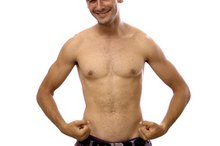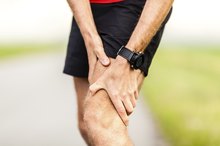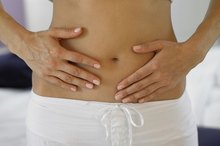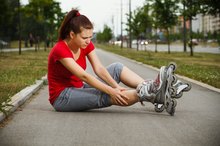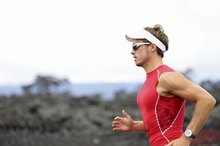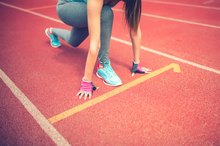What does fact checked mean?
At Healthfully, we strive to deliver objective content that is accurate and up-to-date. Our team periodically reviews articles in order to ensure content quality. The sources cited below consist of evidence from peer-reviewed journals, prominent medical organizations, academic associations, and government data.
The information contained on this site is for informational purposes only, and should not be used as a substitute for the advice of a professional health care provider. Please check with the appropriate physician regarding health questions and concerns. Although we strive to deliver accurate and up-to-date information, no guarantee to that effect is made.
Abdominal Cramps While Cycling
Often painful and debilitating, stomach cramps can seriously impact your ability to complete an exercise session. Whether you are running, cycling, swimming, rowing or walking, stomach cramps can occur for a wide variety of reasons. In fact, abdominal cramps while cycling can be just as distressing as muscle cramps in the legs or feet.
If you are experiencing serious medical symptoms, seek emergency treatment immediately.
Dehydration
As with any form of exercise, your cycling performance depends heavily on your hydration level. As you exercise, your body loses a tremendous amount of water through perspiration. If you do not replace this water, you become dehydrated. Early signs of dehydration include a dry mouth, thirst, fatigue and headache 2. However, as the dehydration worsens, the body’s internal functioning suffers and additional symptoms appear 2. Symptoms of severe dehydration include stomach cramps, muscle cramps, lack of sweat, low blood pressure and rapid heart rate 2.
- As with any form of exercise, your cycling performance depends heavily on your hydration level.
- As you exercise, your body loses a tremendous amount of water through perspiration.
Hyponatremia
Sit Ups Before Bed to Lose Weight
Learn More
When you sweat, your body releases more than just water -- a copious amount of salt is also released through the sweat. If you do not replace this sodium while you are cycling, it can cause significant problems. Sodium attracts water, so it is important for maintaining fluid balance in the body. Drinking large amounts of water while cycling can further exacerbate the problem. Since sodium is responsible for moving water between the stomach and the blood, the water you drink ends up sitting inside the stomach and causing major discomfort. Along with stomach cramps, hyponatremia also causes bloating, nausea, headaches and confusion.
- When you sweat, your body releases more than just water -- a copious amount of salt is also released through the sweat.
- Since sodium is responsible for moving water between the stomach and the blood, the water you drink ends up sitting inside the stomach and causing major discomfort.
Gastrointestinal Upset
Eating too much before or during a long cycling session can easily result in stomach discomfort and abdominal cramping. When you have food inside the stomach, your body must send blood and energy to the organ to assist with digestion. As your stomach churns and processes the food, the stomach muscle must compete with your leg muscles that are working to pedal your bike. Before cycling, avoid eating foods that are high in fiber. If you have a sensitive stomach, avoid eating three to four hours before riding. Otherwise, avoid eating in the two hours before riding. If you plan on cycling for longer than two hours, stick with sports drinks and carbohydrate energy gels to meet your calorie needs.
- Eating too much before or during a long cycling session can easily result in stomach discomfort and abdominal cramping.
- If you plan on cycling for longer than two hours, stick with sports drinks and carbohydrate energy gels to meet your calorie needs.
Side Stitch
How to Get a Six Pack As a Teenager
Learn More
Although a side stitch does not actually affect the abdominal muscles, it causes sharp pain near the stomach, directly underneath the rib cage. A side stitch occurs when the diaphragm muscle spasms. Side stitches can be caused by a wide variety of factors, from exercising too vigorously or shallow breathing during a workout. Having undigested food in your stomach while cycling can also cause a side stitch, although it is more likely to cause a stomach cramp. Once the pain develops, take a deep breath and hold it for a few seconds before exhaling suddenly. If the pain persists, slow down and bend backwards gently to stretch the muscle. If necessary, get off your bike and lie down for a few minutes until the side stitch relieves itself.
- Although a side stitch does not actually affect the abdominal muscles, it causes sharp pain near the stomach, directly underneath the rib cage.
- Having undigested food in your stomach while cycling can also cause a side stitch, although it is more likely to cause a stomach cramp.
Related Articles
References
- Cycling Performance Tips: Basics of Nutrition Physiology for Training and Performance
- Mayo Clinic: Dehydration
- Morton D, Callister R. Exercise-related transient abdominal pain (ETAP). Sports Med. 2015;45(1):23-35. doi:10.1007/s40279-014-0245-z
- ter Steege RW, Kolkman JJ. Review article: The pathophysiology and management of gastrointestinal symptoms during physical exercise, and the role of splanchnic blood flow. Aliment Pharmacol Ther. 2012;(35)5:516-28. doi:10.1111/j.1365-2036.2011.04980.x
- de Oliveira EP, Burini RC. Food-dependent, exercise-induced gastrointestinal distress. J Int Soc Sports Nutr. 2011;8:12. doi:10.1186/1550-2783-8-12
- Fitzgerald M. The New Rules of Marathon and Half-Marathon Nutrition: A Cutting-Edge Plan to Fuel Your Body Beyond "the Wall". Hachette Books, 2013.
- Williamson E. Nutritional implications for ultra-endurance walking and running events. Extrem Physiol Med. 2016;5:13. doi:10.1186/s13728-016-0054-0
- Gupta M. Sugar substitutes: Mechanism, availability, current use and safety concerns--an update. Open Access Maced J Med Sci. 2018;6(10):1888-1894. doi:10.3889/oamjms.2018.336
- Kanter M. High-quality carbohydrates and physical performance: Expert panel report. Nutr Today. 2018;53(1):35-39. doi:10.1097/NT.0000000000000238
- Deng Y, Misselwitz B, Dai N, Fox M. Lactose intolerance in adults: Biological mechanism and dietary management. Nutrients. 2015;7(9):8020-35. doi:10.3390/nu7095380
- Orrù S, Imperlini E, Nigro E, et al. Role of functional beverages on sport performance and recovery. Nutrients. 2018;10(10). doi:10.3390/nu10101470
- Academy of Nutrition and Dietetics. Timing your pre- and post-workout nutrition. Updated September 2019.
- U.S. Food and Drug Administration. The benefits and risks of pain relievers. Updated September 24, 2015.
- Lipman GS, Shea K, Christensen M, et al. Ibuprofen versus placebo effect on acute kidney injury in ultramarathons: A randomised controlled trial. Emerg Med J 2017;34:637-642. doi:10.1136/emermed-2016-206353
- Pickering C, Grgic J. Caffeine and exercise: What next?. Sports Med. 2019;49(7):1007-1030. doi:10.1007/s40279-019-01101-0
- National Institutes of Health. Irritable bowel syndrome. Updated November 2017.
Writer Bio
Krista Sheehan is a registered nurse and professional writer. She works in a neonatal intensive care unit (NICU) and her previous nursing experience includes geriatrics, pulmonary disorders and home health care. Her professional writing works focus mainly on the subjects of physical health, fitness, nutrition and positive lifestyle changes.

